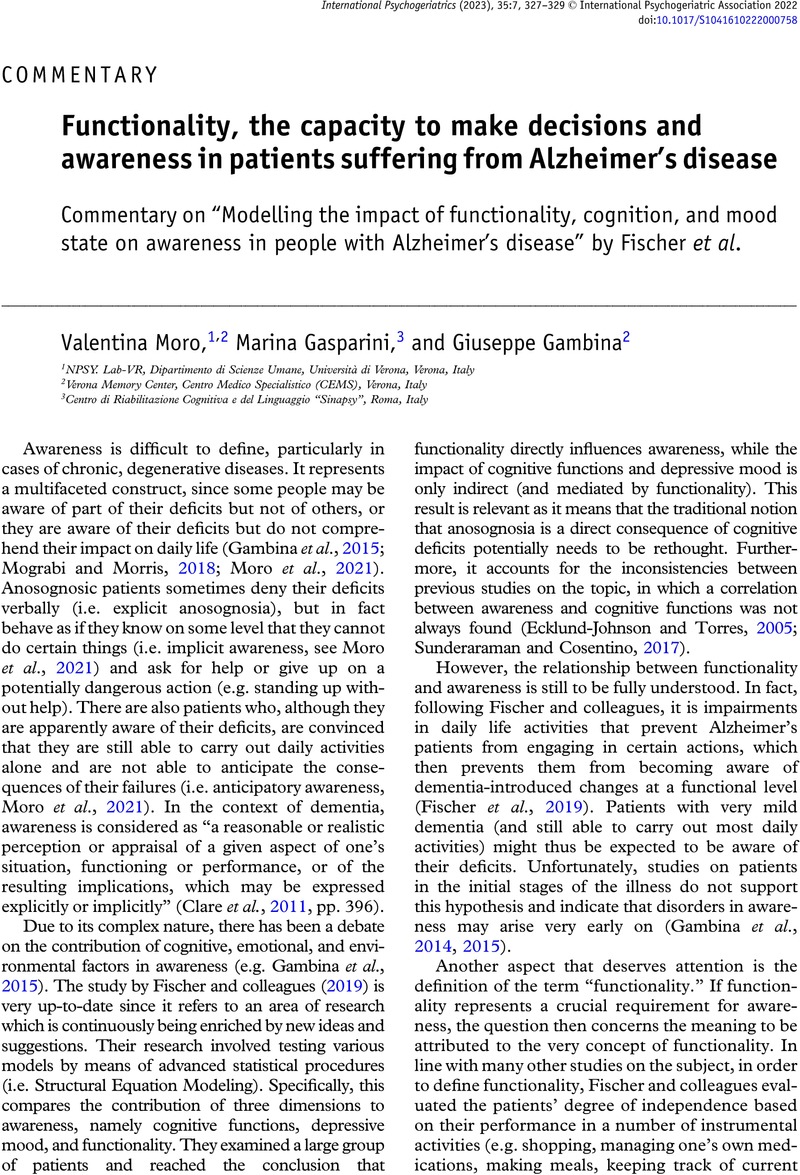No CrossRef data available.
Article contents
Functionality, the capacity to make decisions and awareness in patients suffering from Alzheimer’s disease
Commentary on “Modelling the impact of functionality, cognition, and mood state on awareness in people with Alzheimer’s disease” by Fischer et al.
Published online by Cambridge University Press: 31 August 2022
Abstract
An abstract is not available for this content so a preview has been provided. Please use the Get access link above for information on how to access this content.

- Type
- Commentary
- Information
- International Psychogeriatrics , Volume 35 , Special Issue 7: Issue Theme: Neurocognitive Disorders: Predictors, Mood, and Care , July 2023 , pp. 327 - 329
- Copyright
- © International Psychogeriatric Association 2022
References
Antoine, N. et al. (2019). Anosognosia and default default mode subnetwork dysfunction in Alzheimer’s disease. Human Brain Mapping, 40, 5330–5340. DOI 10.1002/hbm.24775.CrossRefGoogle ScholarPubMed
Appelbaum, P. S. (2007). Assessment of patients’ competence to consent to treatment. New England Journal of Medicine, 357, 1834–1840.CrossRefGoogle ScholarPubMed
Clare, L., Markova, I. S., Roth, I. and Morris, R. G. (2011). Awareness in Alzheimer’s disease and associated dementias: theoretical framework and clinical implications. Aging & Mental Health, 15, 936–944. DOI 10.1080/13607863.2011.583630.CrossRefGoogle ScholarPubMed
Ecklund-Johnson, E. and Torres, I. (2005). Unawareness of deficits in Alzheimer’s disease and other dementias: operational definitions and empirical findings. Neuropsychology Review, 15, 147–166. DOI 10.1007/s11065-005-9026-7.CrossRefGoogle ScholarPubMed
Fischer, A., Dourado, M. C. N., Laks, J., Landeira-Fernandez, J., Morris, R. G. and Mograbi, D. C. (2019). Modelling the impact of functionality, cognition, and mood state on awareness in people with Alzheimer’s disease. International Psychogeriatrics, 35, 361–371. DOI 10.1017/S1041610219001467.Google Scholar
Freedman, M., Stuss, D. and Gordon, M. (1991). Assessment of competency: the role of neurobehavioral deficits. Annals of Internal Medicine, 115, 203–208.CrossRefGoogle ScholarPubMed
Gambina, G. et al. (2014). Awareness of cognitive deficits and clinical competence in mild to moderate Alzheimer’s disease: their relevance in clinical practice. Neurological Sciences, 35, 385–390. DOI 10.1007/s10072-013-1523-5.CrossRefGoogle ScholarPubMed
Gambina, G. et al. (2015). The Italian validation of the Anosognosia Questionnaire for Dementia in Alzheimer’s disease. American Journal of Alzheimer’s Disease & Other Dementiasr, 30, 635–644. DOI 10.1177/1533317515577185.CrossRefGoogle ScholarPubMed
Gasparini, M., Moro, V., Amato, S., Vanacore, N. and Gambina, G. (2021). The evaluation of capacity in dementia: ethical constraints and best practice. A systematic review. Annali dell'Istituto Superiore di Sanità, 57, 212–225. DOI 10.4415/ANN_21_03_04.Google ScholarPubMed
Gossman, W., Lee, M. and Goldstein, S. (2017). EMS, Capacity and Competence. Treasure Island, FL: Stat Pearls Publishing.Google Scholar
Kim, S. (2011). The ethics of informed consent in Alzheimer disease research. Nature Reviews Neurology, 7, 410–414. DOI 10.1038/nrneurol.2011.76.CrossRefGoogle ScholarPubMed
Kim, S. and Appelbaum, P. (2006). The capacity to appoint a proxy and the possibility of concurrent proxy directives. Behavioral Sciences & the Law, 24, 469–478.CrossRefGoogle ScholarPubMed
Moberg, P. and Kniele, K. (2006). Evaluation of competency: ethical considerations for neuropsychologists. Applied Neuropsychology, 13, 101–114. DOI 10.1207/s15324826an1302_5.CrossRefGoogle ScholarPubMed
Mograbi, D. C. and Morris, R. G. (2018). Anosognosia. Cortex, 103, 385–386. DOI 10.1016/j.cortex.2018.04.001.CrossRefGoogle ScholarPubMed
Moro, V. et al. (2020). Comprehension of written texts for the assessment of clinical competence and decision making in people with mild to moderate Alzheimer disease. Neurological Sciences, 41, 1225–1231. DOI 10.1007/s10072-019-04228-0, Erratum in: Neurological Sciences, 2020, Jan. 16.CrossRefGoogle ScholarPubMed
Moro, V. et al. (2021). The Motor Unawareness Assessment (MUNA): a new tool for the assessment of Anosognosia for hemiplegia. Journal of Clinical and Experimental Neuropsychology, 43, 91–104. DOI 10.1080/13803395.2021.1876842.CrossRefGoogle Scholar
Moye, J., Marson, D. C. and Edelstein, B. (2013). Assessment of capacity in an aging society. American Psychologist, 68, 158–171. DOI 10.1037/a0032159.CrossRefGoogle Scholar
Pacella, V. et al. (2019). Anosognosia for hemiplegia as a tripartite disconnection syndrome. eLife, 8, e46075. DOI 10.7554/eLife.46075.CrossRefGoogle ScholarPubMed
Pfeffer, R. I., Kurosaki, T. T., Harrah, C. H., Chance, J. M. and Filos, S. (1982). Measurement of functional activities in older adults in the community. Journal of Gerontology, 37, 323–329. DOI 10.1093/geronj/37.3.323.CrossRefGoogle ScholarPubMed
Sunderaraman, P. and Cosentino, S. (2017). Integrating the constructs of anosognosia and metacognition: a review of recent findings in dementia. Current Neurology and Neuroscience Reports, 17, 27. DOI 10.1007/s11910-017-0734-1.CrossRefGoogle ScholarPubMed




